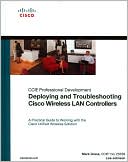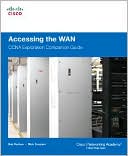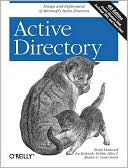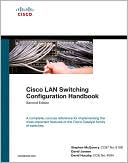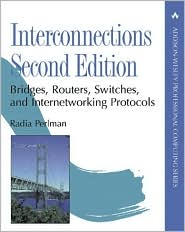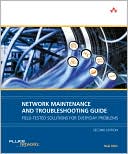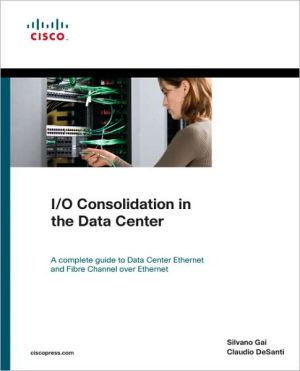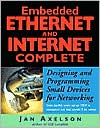Deploying and Troubleshooting Cisco Wireless LAN Controllers
Search in google:
This is the only complete, all-in-one guide to deploying, running, and troubleshooting wireless networks with Cisco® Wireless LAN Controllers (WLCs) and Lightweight Access Point Protocol (LWAPP)/Control and Provisioning of Wireless Access Points (CAPWAP). Authored by two of the most experienced Cisco wireless support professionals, the bookpresents start-to-finish coverage of implementing WLCs in existing wired and wireless network environments, troubleshooting design-related issues, and using LWAPP/CAPWAP solutions to achieve your specific business and technical goals.One step at a time, you’ll walk through designing, configuring, maintaining, and scaling wireless networks using Cisco Unified Wireless technologies. The authors show how to use LWAPP/CAPWAP to control multiple Wi-Fi wireless access points at once, streamlining network administration and monitoring and maximizing scalability.Drawing on their extensive problem-resolution experience, the authors also provide expert guidelines for troubleshooting, including an end-to-end problem-solving model available in no other book.Although not specifically designed to help you pass the CCIE® Wireless written and lab exams, this book does provide you with real-world configuration and troubleshooting examples. Understanding the basic configuration practices, how the products are designed to function, the feature sets, and what to look for while troubleshooting these features will be invaluable to anyone wanting to pass the CCIE Wireless exams. Efficiently install, configure, and troubleshoot Cisco Wireless LAN Controllers Move autonomous wireless network solutions to LWAPP/CAPWAP Integrate LWAPP/CAPWAP solutions into existing wired networks Understand the next-generation WLC architecture Use Hybrid REAP and Home AP solutions to centrally configure and control branch/remote access points without deploying controllers in every location Use Mobility Groups to provide system-wide mobility easily and cost-effectively Use Cisco WLC troubleshooting tools, and resolve client-related problems Maximize quality in wireless voice applications Build efficient wireless mesh networks Use RRM to manage RF in real-time, optimizing efficiency and performance Reference the comprehensive WLC and AP debugging guidePart of the CCIE Professional Development Series, this is the first book to offer authoritative training for the new CCIE Wireless Exam.It will also serve as excellent preparation for Cisco’s newCCNP® Wireless exam.
Introduction xviiiChapter 1 Troubleshooting Strategy and Implementation 1Developing a Troubleshooting Strategy 1Production Versus Nonproduction Outages 1Step 1: Gathering Data About the Problem 2Step 2: Identifying the Problem 2Step 3: Isolating the Problem 3Step 4: Analyzing the Data Collected About the Problem 7Summary 9Chapter 2 Wireless LAN Controllers and Access Points 11Wireless LAN Controller Platforms 11Current Production WLCs 12Previous WLCMs 15Functionality Differences Between WLCs 17WLC Hardware and Software Requirements 19Lightweight AP Models 20Cisco Aironet APs 20Airespace APs 25AP 1000 Series Functionality Differences 26AP 1000 Series Limitations 26Lightweight Compared to Traditional Autonomous APs 28Scalability 28RRM 29Self-Healing Mechanism 30WLC Features 30Central Management 32Summary 35Chapter 3 Introduction to LWAPP 37Defining LWAPP 37Quick Protocol Overview 38LWAPP Advantages 41Management 42Scalability 42Security 43Mobility 43LWAPP Mechanics 44Discovery Process 45Join Process 55Image Process 56Config State 56Run State 57Dissecting the Discovery Response 58Manually Dissecting the Discovery Response 59Summary 61Chapter 4 The CAPWAP Protocol 63Overview of CAPWAP 64Differences from LWAPP 65CAPWAP Session Establishment/AP Joining Process 67Discovery Process 70DTLS Session Establishment 71Join/Config/Run 81Troubleshooting CAPWAP Session Establishment/AP Discovery and Join 90CAPWAP Communication: Control and Data Encryption 98CAPWAP Communication: Sequence Numbers and Retransmissions 100CAPWAP Fragmentation and Path MTU Discovery 101CAPWAP-Control Packets Fragmentation 101CAPWAP-Data Packets Fragmentation 101CAPWAP—MTU DISCOVERY and TCP-MSS Adjustment 102802.11 Bindings and Payloads 103CAPWAP-Data Binding and Payloads 103CAPWAP-Control Binding and Payloads 104LWAPP and CAPWAP Vendor-Specific Payloads 105Summary 105Chapter 5 Network Design Considerations 107Controller Placement 107Access Layer Deployments 108Distribution Layer Deployments 109Service Block Deployments 109WAN Considerations 110AP Placement 110Dense AP Deployment Considerations 112802.11n 114Location Design Considerations 116Summary 119Chapter 6 Understanding the Troubleshooting Tools 121Troubleshooting on the WLC 121Debugging 121Advanced Debugging 126mping and eping 131Message Log 132Trap Log 133Statistics 135Controller Statistics 135AP Statistics 135RADIUS Server Statistics 137Port Statistics 137Mobility Statistics 138Packet Captures 139WLC Config Analyzer 140Software Bug Toolkit 141Summary 142Chapter 7 Deploying and Configuring the Wireless LAN Controller 143Connecting the WLC to the Switch 144Multiple AP-Manager Support 145LAG 148Layer 2 and Layer 3 LWAPP Transport Modes of Operation 151LWAPP Layer 3 Transport Mode 153Interfaces on the WLC 156DHCP Proxy Vs. DHCP Bridging 159DHCP Proxy Mode 160DHCP Bridging Mode 163Overview and Configuration 163Configure the Switch for the WLC 169Troubleshooting WLC Issues 171Summary 176Chapter 8 Access Point Registration 177AP Discovery and Join Process 177Troubleshooting Network Connectivity and AP Registration 181Verifying VLAN Configuration 181Verifying IP Addressing Information 182Understanding the AP Discovery and AP Join Process 183Troubleshooting the AP Discovery and AP Join Process 191WLC Config Analyzer 197AP Debugs 198Debug Template 198Summary 199Chapter 9 Mobility 201Client Roaming/Mobility Events 202Intra-Controller Roaming 202Inter-Controller Roaming 202Inter-Subnet Roaming/Layer 3 Mobility Events 202Auto-Anchor Mobility 206AP Groups 207Troubleshooting AP Groups 208Mobility Groups 210Mobility Messaging 212Mobility Message Types 212Mobility Role of the Controller to the Client 213Mobility Handoff Types 214Mobility Packet Format 221Error Recovery 223Mobility Messaging Enhancements in 5.0 224Configuring Mobility Groups 224Configuring Auto-Anchoring 226Determining Controllers to Add to a Mobility Group 228Secure Mobility 228Troubleshooting Mobility 229PMKID Caching 238AP Mobility 241Primary, Secondary, and Tertiary Controllers 241AP Load Balancing 243AP Failover 244Troubleshooting AP Mobility 245Summary 247Chapter 10 Troubleshooting Client-Related Issues 249General Client Information 249Client Association Packet Flow 250Client Utilities and Logging 255AP Debugs and Show Commands 258Wireless and Wired Sniffer Traces 261Debug Client 262Debug Client Variations 263Client Connection 265Controller Processes 265PEM 266APF 268802.1x Authentication (Dot1x) 270Debug Client Analysis 270Troubleshooting Examples 285Wrong Client Cipher Configuration 285Wrong Preshared Key 287Incorrect User Credentials with EAP 289Summary 291Chapter 11 Wireless Voice 293Prerequisites for Voice Deployments 293Phone Features 295Supported Protocols, Specifications, and Certifications 295Security 296Coexistence 297QoS 297Latency, Jitter, and Loss 298Correct Packet Marking 298Upstream and Downstream QoS 302Wi-Fi Multimedia 303TSPEC 304Configuration 305Controller 305Switch Ports 311WLAN Profile on the Phone 312Troubleshooting 792x Voice Quality Issues 313Basic Troubleshooting/Connectivity 313Choppy/Lost Audio 316One-Way Voice 319Network Busy 321Poor Audio When Roaming 323Multicast Applications Fail 324Enabling Trace Logs on the 792x 329Troubleshooting and Monitoring Tools 337WCS 338Packet Capture Software 340Spectrum Analysis Tools 341SpectraLink and Vocera Deployments 342SpectraLink 342Vocera Deployments 344Summary 347Chapter 12 Radio Resource Management 349How RRM Works 349RF Grouping 351Dynamic Channel Assignment 357TPC 358Coverage Hole Detection 359Enhancements to RRM 360Configuring RRM 362Dynamic Channel Assignment 363Transmit Power Control (TPC) 365Coverage 367Profiles and Monitor Intervals 368Overriding Global RRM 369Troubleshooting RRM 371SNMP Traps 371show Commands 373Debugs 378Summary 389Chapter 13 H-REAP 391H-REAP Versus REAP 392Split MAC Versus Local MAC Architecture 392H-REAP Modes of Operation 394Central Versus Local Switching 395H-REAP States of Operation 397H-REAP Wireless Security Support 398Configuring H-REAP 398Controller Discovery 398Configuring the WLAN 402Configuring the AP 404Configuring the Local Switch 405H-REAP Guidelines and Limitations 408H-REAP Enhancements 410Backup RADIUS Server 410H-REAP Groups 411Local Authentication 412Troubleshooting H-REAP 412show Commands 414debug Commands 422Summary 430Chapter 14 Guest Networking 431Web Authentication 431Web Authentication Policies 432Web Authentication Types 435Web Authentication Process 436Troubleshooting Basic Web Authentication 440RADIUS and LDAP Authentication with Web Auth 447Guest User Accounts 451Custom Web Auth Splash Pages 452Global Override 453Browser Security Warning 454Centralized Traffic Flow with Guest Access 458Auto-Anchor/Guest Tunneling 458Configuring Auto-Anchor 460Troubleshooting Guest Tunneling 461Wired Guest Access 467Troubleshooting Wired Guest Access 470Summary 471Chapter 15 Mesh 473Mesh Code Releases 474Mesh Deployments 474How Mesh Works 476Mesh Bootup and Join Process 477Configuring Mesh 480Ethernet Bridging 483Troubleshooting Mesh 488AP Join Problems 488RF Issues 491show Commands 492Remote Telnet and AP Debugs 495Ethernet Bridging Troubleshooting 497Summary 502Appendix A Debugging Commands 503WLC Debugs 503Existing Debugs in Software Version 5.0 and Earlier 503Debugs Introduced in Software Version 5.1 518Debugs Introduced in Software Version 6.0 520Debug Packet Logging 523AP Debugs 526Appendix B LWAPP and CAPWAP Payloads 535LWAPP and CAPWAP Message Payloads 544TOC, 9781587058141, 10/19/09
